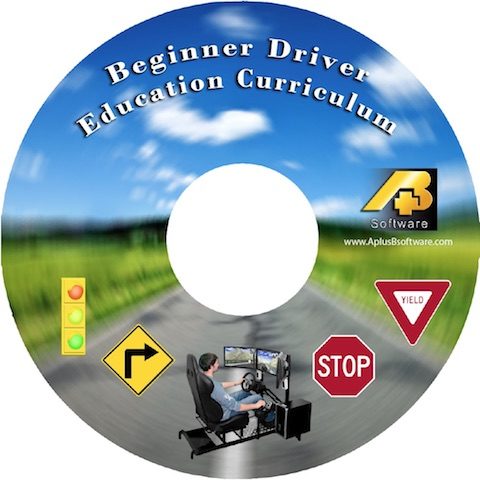Developed by a team of experts our curriculum is a balance of multimedia, lecture, group work, simulator and in-car practice designed to help students become the best drivers possible.
AplusB offers the high quality driving instruction and driver training for beginner students. Our up to date and detailed driving course prepare students to pass their road tests and become safe and effective drivers for years to come!
| Product Price: | $100.00 | ||
| Shipping & Handling: |
|
AplusB ensures that this Beginner Driver Education (BDE) Curriculum follows and meets high standards of quality. This BDE is the result of the combined efforts of various stakeholders within the driving school industry, research experts and subject matter experts.
Quality BDE provides a foundation for safe and responsible driving and serves as a valuable opportunity to help develop positive driving attitudes and behaviors in new drivers.
The goal of the BDE Curriculum is to improve all procedures being delivered in order to:
- Enhance road safety for all road-users;
- Improve the driving competency of beginner drivers;
- Help beginner drivers develop respectful and responsible attitudes toward driving that contribute to the safety of all road users;
- Enhance driver mobility by helping beginner drivers to drive in a confident and safe manner whenever they need to drive.
Our BDE in conjunction with the SimuRide simulator is a modern, flexible approach to Beginner Driver Education.
Put your driving school ahead of the competition with AplusB Software’s flexible, Beginner Driver Education curriculum that incorporates the SimuRide – DRIVER SIMULATOR, a modern teaching method.
Put your driving school ahead of the competition with AplusB Software’s flexible, Beginner Driver Education curriculum that incorporates the SimuRide – DRIVER SIMULATOR, a modern teaching method.
What you will get with our BDE Curriculum?
- 18 classroom lessons varying in length from 20 to 50 minutes
- Up to 10 hours of independent study exercises
- 10 hours of in-car lesson plans.
The instructional mix in hours:
- Direct 6.4
- Indirect 2.9
- Interactive 8.2
- Independent 3.9
- Homework 5.5
- Simulator 3.1
- Total Hours 30.0
Exercises and activities are included in the lesson plans to evaluate student progress. There are instructor notes for each lesson and optional student handout packs.
No prior experience in driver training is required to instruct. The lessons are based upon the following standards:
- Rules of the Road
- The Vehicle and its Components
- Vehicle Handling
- Driver Behavior
- Respect and Responsibility
- Sharing the Road
- Attention
- Perception and Risk Management
The BDE can be used in conjunction with the SimuRide PE Driving Simulator.
An effective learning environment
For students to be able to learn effectively, they must remain alert, interested and engaged.
The curriculum described in this guide incorporates a mix of direct classroom instruction interspersed with regular discussion and group activities, as well as opportunities for interactive and independent learning.
Students are assisted in classroom instruction through handouts which remove the need for extensive note taking – thereby allowing students to participate actively in discussions – but which encourage the writing of key words and concepts to stimulate memory.
BDE Curriculum Materials
Curriculum materials are complemented by instructors’ notes which offer example questions to stimulate frequent discussions of the main topics, encouraging students to lead the lesson and have ownership of the content.
The classroom sessions are designed to be wholly interactive, where information is delivered in an environment of discussion and interaction, and continual assessment of learning takes place.
The SimuRide simulator, that can be used with the BDE, allows students to establish critical observation, reaction, and decision making skills in the safety of the classroom.
It allows other students and instructors the opportunity to discuss realistic driving situations, and to observe peers in real-life driving situations.
It enable instructors to introduce examples of driving hazards, conditions, and strategies immediately after the classroom instruction, helping students to place the classroom learning in context with real applications for driving.
The SimuRide also has an option to use the simulated skid car. The SimuRide skid car allows students to safely experience the more common types of skids and slides that they may experience when they progress to the roads.
A proactive driving style is reinforced through teaching smooth and controlled steering, braking, and acceleration techniques. The students can safely learn how to avoid and how to handle loss of vehicle control.
The SimuRide has additional benefits for driving schools. It improves safety by giving students the opportunity to experience a variety of driving conditions, and to become familiar with handling and controls, before they enter an actual vehicle.
This is a valuable assurance to students, instructors, parents and other road users. The hours spent on the SimuRide do not incur the same costs as hours in a car, This saves on insurance, gas and instructor time, as several students can be experiencing driving at once under the direction of a single instructor.
Classroom lesson plans include time allocation and guidance for instructors on how students use the SimuRide, and how to assess their experience and contribute to their learning.
The lesson plans are designed to allow students to work in small groups or individually on the SimuRide. This enables instructors to adapt the lessons to suit the ratio of students to SimuRide stations available.
Instructors should keep note of student progression through the various SimuRide scenarios, to ensure that all students receive training and practice, and that each student progresses at his/her own individual rate.
Students also progress through the curriculum with in-car instruction and practice. Effective in-car learning also requires students to be interested, alert and engaged.
Unlike in the classroom, where students may have additional distractions and experience nervousness or stress. The in-car learning environment is much more calm and focused on the task.
Instructors need to be patient, yet assertive, clear and firm with their instructions. The in-car environment must be safe, and free of any unnecessary distractions.
Generally, it is not recommended to have other students as passengers during in-car instruction, although in some cases this cannot be avoided.
Where other students must be passengers during instruction, they must understand that they cannot distract the driver, take part in conversations that may interfere with the instructor’s directions, or block the driver’s view in any way.
In-car learning is arguably the most significant part of the curriculum. Demonstrations by the instructor should be kept to a minimum, allowing students the greatest possible time to experience driving the vehicle and developing their skills of observation and reaction, as well as their competence in controlling the car.
The in-car lesson plans are designed to ensure that in-car instruction is as structured and effective as in the classroom, in that it follows a program of skill development, and that students’ learning is continually assessed.
Students should also be encouraged to practice what they are learning between formal instruction sessions. The instructor can help students identify a fully qualified driver in their life to act as a driving mentor and can assist in ensuring the success of this activity by providing the tools and materials necessary for practice outside the instructional hours.






